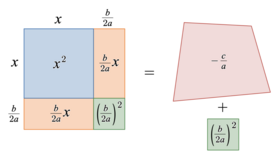
A | B | C | D | E | F | G | H | CH | I | J | K | L | M | N | O | P | Q | R | S | T | U | V | W | X | Y | Z | 0 | 1 | 2 | 3 | 4 | 5 | 6 | 7 | 8 | 9

In elementary algebra, the quadratic formula is a closed-form expression describing the solutions of a quadratic equation. Other ways of solving quadratic equations, such as completing the square, yield the same solutions.
Given a general quadratic equation of the form , with representing an unknown, and coefficients , , and representing known real or complex numbers with , the values of satisfying the equation, called the roots or zeros, can be found using the quadratic formula,
where the plus–minus symbol "" indicates that the equation has two roots.[1] Written separately, these are:
The quantity is known as the discriminant of the quadratic equation.[2] If the coefficients , , and are real numbers then when , the equation has two distinct real roots; when , the equation has one repeated real root; and when , the equation has no real roots but has two distinct complex roots, which are complex conjugates of each other.
Geometrically, the roots represent the values at which the graph of the quadratic function , a parabola, crosses the -axis: the graph's -intercepts.[3] The quadratic formula can also be used to identify the parabola's axis of symmetry.[4]
Derivation by completing the square

The standard way to derive the quadratic formula is to apply the method of completing the square to the generic quadratic equation .[5][6][7][8] The idea is to manipulate the equation into the form for some expressions and written in terms of the coefficients; take the square root of both sides; and then isolate .
We start by dividing the equation by the quadratic coefficient , which is allowed because is non-zero. Afterwards, we subtract the constant term to isolate it on the right-hand side:
The left-hand side is now of the form , and we can "complete the square" by adding a constant to obtain a squared binomial
Antropológia
Aplikované vedy
Bibliometria
Dejiny vedy
Encyklopédie
Filozofia vedy
Forenzné vedy
Humanitné vedy
Knižničná veda
Kryogenika
Kryptológia
Kulturológia
Literárna veda
Medzidisciplinárne oblasti
Metódy kvantitatívnej analýzy
Metavedy
Metodika
Text je dostupný za podmienok Creative
Commons Attribution/Share-Alike License 3.0 Unported; prípadne za ďalších
podmienok.
Podrobnejšie informácie nájdete na stránke Podmienky
použitia.
www.astronomia.sk | www.biologia.sk | www.botanika.sk | www.dejiny.sk | www.economy.sk | www.elektrotechnika.sk | www.estetika.sk | www.farmakologia.sk | www.filozofia.sk | Fyzika | www.futurologia.sk | www.genetika.sk | www.chemia.sk | www.lingvistika.sk | www.politologia.sk | www.psychologia.sk | www.sexuologia.sk | www.sociologia.sk | www.veda.sk I www.zoologia.sk
























